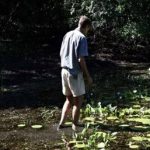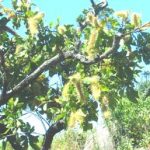TREE LIFE
July 2015
MASHONALAND CALENDAR
Saturday July 4th: Botanic Gardens Walk:
A good time of year to be out in the gardens. Meet in main car park at 0845 hours for 0900 hours start. This walk will last about an hour and a half.
Sunday 19th July : Outing to Bob Warren Codrington’s property off Alps Road.
We plan to visit an interesting area where we have not been before. Bring the usual, picnic lunch and nibbles and drinks, chairs, hats and a bonsella for the car guard.
Saturday 275h July: Outing to the home of Doreen Richards and Mike Caufield. There is a wealth of botanising to be done here – not only trees!
We will meet there at 1430 hours.
TREE OF THE MONTH Azanza garckeana
Family: – Malvaceae. (Hibiscus & Cotton family). Common names: Snot apple; Nd: Uxhakhuxhakhu; Sh: Muthowe.
Etymology: The name Azanza comes from the Mexican name for one of the members of the genus, the specific name comes from Christian Garcke (1819-1904), a botanist and plant collector.
In Zimbabwe the indigenous Malvaceae are represented by several wild Hibiscus species as well as Abutilon pycnodon and Azanza garckeana, but obviously the most economically important Malvaceae in Zimbabwe is the cotton plant, Gossypium hirsutum. Back to our Uxhakhuxhakhu or Snot Apple, it is widespread in all sorts of terrain in Zimbabwe but does not appear to form pure stands.
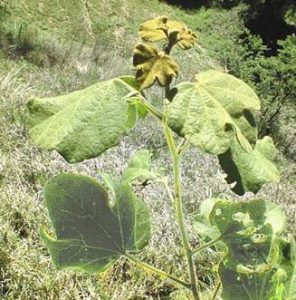
Azanza garckeana leaves
This is a small tree from 3 metres upward to, I believe, 10 m but I still have to see one that big. The bark is grey to brownish, smooth on a young tree and getting progressively rougher with age. The branchlets are generally covered with dense brown woolly hair.
The leaves are spirally arranged on the branchlets; they are simple, 3- to 5 lobed and are 5- to 7 veined from the base. The young leaves are covered in woolly hair that gradually diminishes with age. A very interesting feature of the leaves is the extrafloral nectary on the central vein, this is a most certain sign that you are not looking at a Dombeya rotundifolia, which never has the extrafloral nectary. The leaves are generally in the range of 8 to 10 cm but I have seen leaves over 20 cm in diameter on coppice growth.
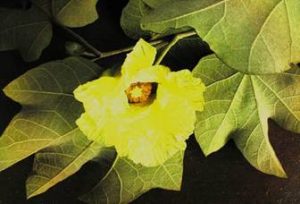
Azanza garckeana flowers
The flowers are very pretty starting yellow and crinkly like poppies and becoming orange and red later. The fruit is a woody capsule nearly spherical divided in 5 sections covered with hair and very reminiscent of cotton fruits.
The tree fruits from February onwards and in Matabeleland is relished by all children, even by adults. In fact should you want to practice your click-sounds, start chewing the gelatinous flesh of Snot Apple and say Uxhakhuxhakhu.
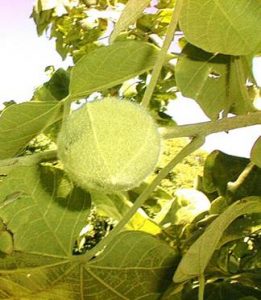
Azanza garckeana fruit
The fruits are the most useful part of Azanza garckeana, eaten either slightly green or ripe. They are persistent and therefore can be picked on ripening. Some people dry them and reconstitute them later. They can also be soaked in a small amount of water to make jelly, boiled and used as relish, or made into porridge. Leaves are used for making relish and can be burned and used as salt. They can also be cooked and used as a vegetable, or as a green manure just as we use Cajanus cajan (Nyandoro).
Timber: the wood of Azanza garckeana has many uses, which are appreciated by people living in rural areas. The wood is a source of fuel in areas where there is shortage of firewood and can also be converted into charcoal, or used for construction materials, poles, fencing posts, farm implements, tool handles and domestic utensils.
Fodder: Leaves are eaten by game and livestock and are a source of fodder during the dry season. Miscellaneous uses: The long shoots are traditionally used as whips and the inner bark is a source of fibre. The species is not associated with any medicinal uses.
Trees left when clearing crop fields provide shade to people during the cropping season. Azanza garckeana suckers freely and has been used in soil conservation. The tree is commonly grown for ornamental purposes.
Sources:
Coates Palgrave, K. 1977. Trees of Southern Africa. Struik, Cape Town.
Gelfand, M. et.al. 1985. The Traditional Medical Practitioner in Zimbabwe. Mambo Press, Gweru.
Goldsmith, B. and Carter, D.T. 1992. The Indigenous Timbers of Zimbabwe. Forestry Commission, Harare.
PlantzAfrica – Website of the South African Botanical Institute. www.plantzafrica.com
Mojeremane, W, and Tshwenyane, S.O. 2004. Azanza garckeana: A Valuable Edible Indigenous Fruit Tree of Botswana.
Nyathi, P. 2001. Traditional ceremonies of the AmaNdebele. Mambo Press, Gweru.
Van Wyk, B. and Van Wyk, P. 1997. Field Guide to the Trees of Southern Africa . Struik, Cape Town.
Wikipedia: www.wikipedia.com
Photographs: JP Felu.
– JP Felu
TREE SOCIETY VISIT TO CATAPU, SOFALA PROVINCE, MOZAMBIQUE 25th APRIL – 2ND MAY 2015
CONTINUED
Tuesday 28th April
At breakfast Ant White gave us a short history of Catapú and the operations of the company TCT Dalmann and following that we gathered at the sawmill where Ant met us and led the group around all the different sections. We had a very interesting morning learning about all the activities that are involved in the production of fine timber for furniture making.
All the land allocated for logging concessions in the Cheringoma District of Sofala Province were set up by the UN as part of the 2001 Gerffa Initiative, with the idea that Northern Sofala would form a conservation area that would provide an experimental platform for long-term sustainable commercial projects in agriculture, forestry, hunting etc.. One of the principle criteria for the logging concessions was that a sawmill had to be established on site. Catapú is however one of the only concessions that has complied with this regulation. The official size limit for harvestable logs is a DBH (diameter at breast/chest height) of, for example, 400mm for Panga Panga and 500mm for Chamfuta. Catapú has decreased the size limit on all species by 50mm to improve sustainability.
The requirement to locate a sawmill in the field was made to firstly stimulate local employment, to offer training to rural people and to uplift the lives of the communities in these impoverished areas. Secondly, as transport is a very high cost component, it was to encourage foresters to establish sawmills in the field so as to not only lower the transport costs (not having to transport heavy logs huge distances to the city based mills), but also to encourage the maximised use of branch-wood and lesser value material. The use and conversion of branch-wood into a commercial product in the field has proven not only to be viable but also has had a positive impact on the sustainable use of raw forest materials. As history has proven, a semi industrial facility in the rural areas has a positive knock-on effect within the communities, with cheap (in many cases free) timber stimulating micro-industries to flourish.
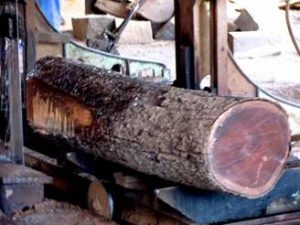
Slicing roundwood into flat planks
In the sawmill the wood is converted from roundwood into flat planks using old Portuguese-manufactured Pinheiro saws, which are labour-intensive but tough and reliable units. These are ideal for far-flung African rural conditions. The blades are sharpened every 40 minutes when milling Panga Panga (Millettia stuhlmannii) (which contains silicone) and every 1.5 hours for Chamfuta (Afzelia quanzensis). Ant uses 10 saws in tandem, the life of a blade is between 6 to 8 months.
The old method of air drying timber has been replaced at Catapú by using modern kilns where sawn boards are stacked meticulously on trolleys, facilitating a roll-in-roll-out system of packing and unpacking the kilns. In the past, 50m cubed of wood every month (a consignment of 5 trolleys) has been dried, 25m cubed being dried in each of two kilns 24 hours a day for 21 days. Sawmill off-cuts and non-commercial branch wood is used to fire the heat exchanger (kettle). For each drying period a turnover of about 8 to 10% of boards do not meet the stringent moisture requirement of under 10% humidity, and are recycled.
A side industry has been evolved at Catapú to maximise the use of brown and white and non furniture-grade wood from the sawing operations. Recovery wood is used to make beehives, low-cost housing panels, school desks and protection gates for the replanted areas, among others. Sawdust is used for mulching when planting trees, as well as making compost.
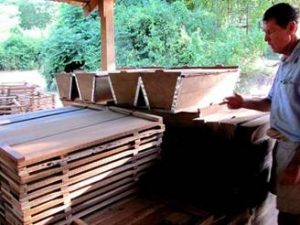
Ant White with bee hives
Once we had had a good look at all the workings of the sawmill, we went across to see another secondary industry using home-made timber lathes. Here community members are trained to make turned items from the abandoned branch-wood on the concession. Maximum use of branch-wood also reduces the fire risk on the property. The men are first trained in all aspects of the trade, including material collection, manufacturing of traditional lathes and tool making. This is done to give them a skill which will allow them to return to their communities and use the high volumes of woody material felled on community lands, the residual of slash and burn agricultural practices. The intricacies of turning fine bowls, lamp stands and candlesticks (amongst other items) are taught, which will empower participants to copy these designs at home. Trained turners who set up their own turning workshops have a ready market at Catapú for their “green” goods. The unfinished items are bought, dried and finished in the Catapú workshops. African blackwood (Dalbergia melanoxylon), a common victim of wild fires, is used only for making musical instruments.
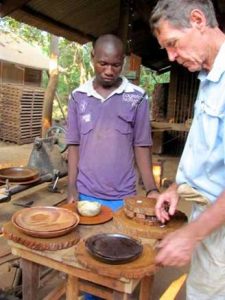
Ant White with finished wood products
Many of us had already seen the workings of the sawmill during our last stay in 2012 but we were all interested to see it functioning again and found we took in more the second time around. This time, however, because of a political hitch, there had been no felling on the concession for some time, so there were no fresh logs to convert into planks. Instead Ant was using up some of the old logs that had been felled in the colonial era that were still in perfect shape and had been stored in the sawmill yard for just such an occasion. Because Ant has now sold the Beira furniture factory and will no longer be producing furniture there after July 2015, the operations at Catapú are changing. They cannot compete with cheap Chinese imports so instead Ant has turned his hand to ‘bespoke’ furniture, based on the lines and grain of the wood, each piece being unique. In addition they are selling blocks of wood to carpentry shops in Europe, where there is a good market for exotic timbers. Ant will also be marketing sawn timber in future. Some of the machinery from the factory will be relocated to Catapú so that the operations are all on one site. Because of a local World Bank bee-keeping initiative that requires thousands of hives, Catapú has become one of the primary beehive producers in the region.
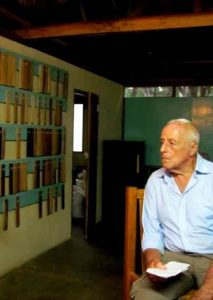
Catapu – Tom Muller in pensive mode
From the sawmill we went to see the honey drying facility. In order to increase the shelf-life of the honey that he purchases from the local beekeepers, Ant uses a dehumidifier to reduce the moisture content, to prevent it from fermenting over time. From there Meg proudly showed us around her Cheringoma Herbarium, with its ever increasing numbers of specimens, and particularly the Xylarium (a labelled wood collection) which had been completed since the last time we visited Catapú.
In the late afternoon the more energetic of the group went botanising along the Suni Trail, which leads into the forest from M’Phingwe Lodge, returning in a loop to the camp just at dusk and in time for cold beer and a delicious supper.
– Isla Grundy
Wednesday 29th April – Inhamitanga Forest and Shupanga
We set off after breakfast in three cars to the Inhamitanga Forest – a short way on the tar heading South, then we turned East, crossed the railway line and followed a narrow forest trail for an hour and then stopped in the middle of the forest.
This forest is a wet lowland forest where the trees seemed taller than in the deciduous Catapú concession, where the trees lose their leaves in winter. In Inhamatanga we were in deep shade with a canopy overhead. There was no grass on the ground level except along the sides of the road. Here there were also pioneer weeds including the largest Bidens pilosa (Blackjacks) I have seen. One of these weeds is American and has been introduced with American food aid. We eventually found a way into the forest through the thick cover of weeds and grass on the road’s edge. The ground was mostly bare with a few understory plants, Strychnos usambarensis, Chazaliella abrupta, the false-birdberry and Zanthoxylum possibly holtzianum. Tiliacora funifera, the Elbowleaf and Mildebraedia carpinifolia, the False-donkeyberry.
The tall trees here are predominantly Panga Panga (Millettia stuhlmannii), the Birdplum (Berchemia discolor) and Drypetes reticulata with a rough bark. A Panga Panga and a Berchemia were growing close together on an anthill. We felt the bark of the two trees and found the bark of the Panga Panga to be much cooler [is this because the sap is nearer the surface under the smooth bark? –Ed]. The Panga Panga has lenticels on the bark and it is able to photosynthesise through the green bark when there are no leaves.
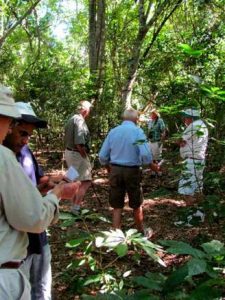
Members in Catapu
We struggled to get a leaf from a tall tree but with John Meikle’s hook and Bilal’s ability to climb up, we secured a good specimen from a Drypetes reticulata. Celtis mildbraedii has characteristic sharp buttresses whereas the Drypetes reticulata’s trunk is fluted. The Sterculia appendiculata (Tall-boy Star-chestnut) tower above the other trees in the forest and are very striking with their white trunks. Cola mossambicensis, a large tree endemic to Mozambique and Malawi, has very long petioles. Alchornea laxiflora a pioneer plant grows along the edge of roads. Xylia torreana, the Sand Ash, is a small to medium size tree with thick woody pods.
After a coffee break we headed on through the forest and stopped by a Panga Panga full of pods. Then on to a magnificent Strangler Fig, Ficus bubu, on the side of the road where the host tree is a Berchemia discolor. Mark was lucky to find a Streblus usambarensis which is very unusual, very distinctive and endemic to the region. It is a shrub or small tree which is dioecious, the leaves are dark green and the margins are toothed. There are catkins along the leaf.
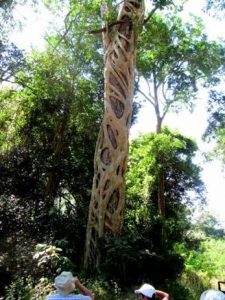
Strangler Fig, Ficus bubu
There were lots of butterflies flitting about yellow, white and blue and brown. We saw very few birds, I understand it is not a good time of the year to see birds and with the good rains the birds and game are scattered through the forest. We ate lunch by the cars in the middle of the road. Then just as we were moving off four very official-looking vehicles came down the road, they wondered who we were so stopped and walked back to find out. They were a team of military officials headed by a full Colonel from Botswana and accompanied by people from both the Government (Frelimo) and Renamo who were checking on the state of the new truce. We were of no consequence, so the meeting ended in smiles and hand shakes.
We then headed on to Shupanga, the site of Mary Moffat’s grave. There is a church and several graves in the graveyard, which is fenced but very overgrown. The head stone had been recently painted. She is such a sad figure who endured so much with childbirth and frequent bouts of malaria. She died in 1862 at the age of 41.
We returned to Mpingwe Lodge via the small town of Caia, where we refuelled. Caia is on the bank of the Zambesi in a very wide floodplain.
At Mpingwe we were very comfortable and enjoyed a drink before dinner, sitting round the fire chatting to the assembled group. They fed us well too. Ant White runs an excellent enterprise managing the forest, the sawmill, the lodge and the honey.
– Ann Sinclair
TO BE CONTINUED……..
TONY ALEGRIA CHAIRMAN


